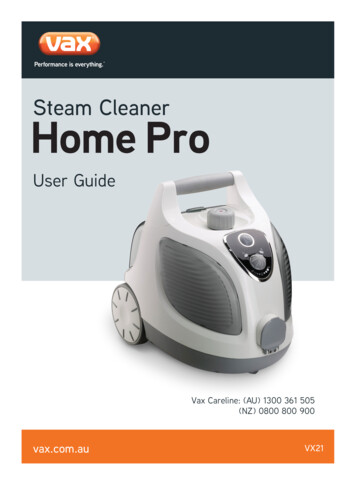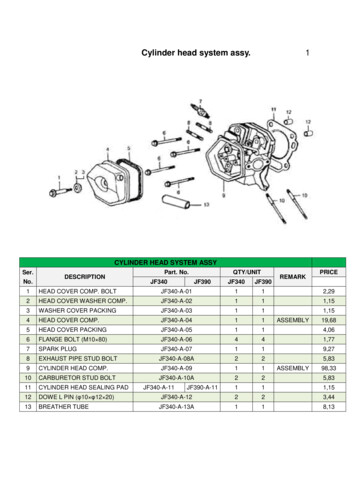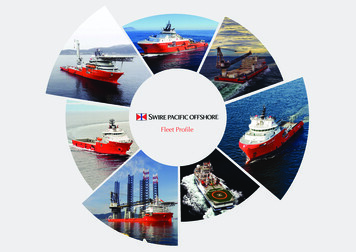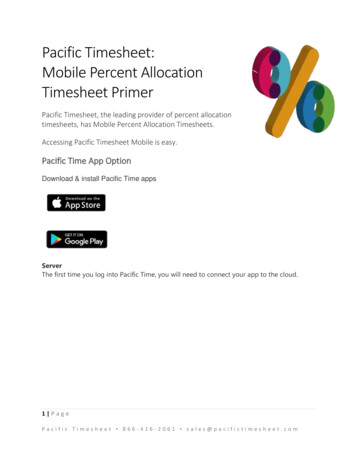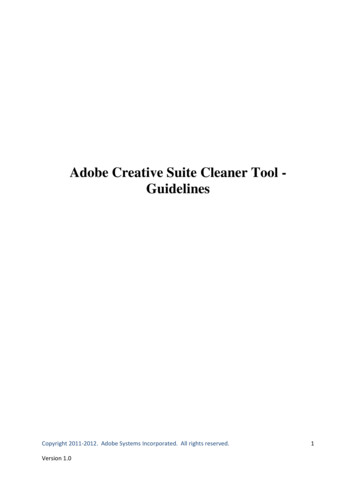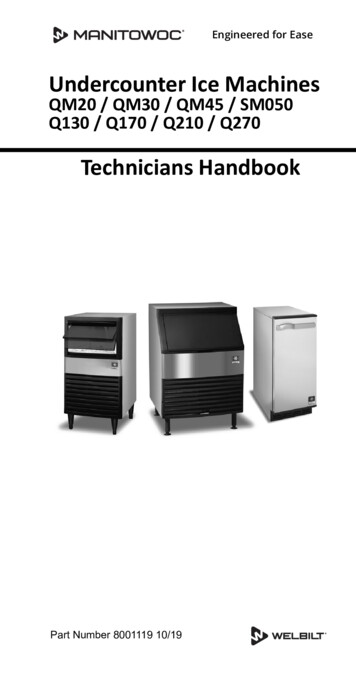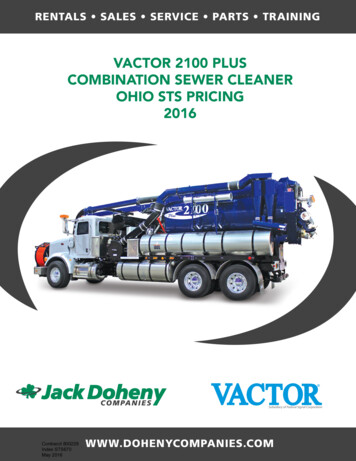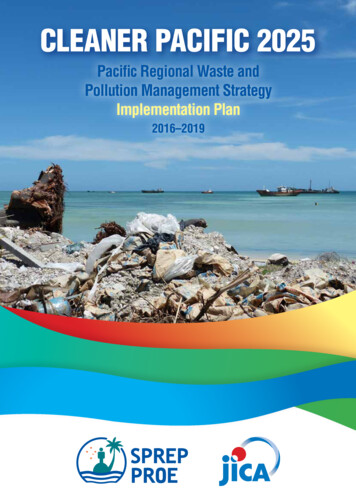
Transcription
CLEANER PACIFIC 2025Pacific Regional Waste andPollution Management StrategyImplementation Plan2016–2019
SPREP Library Cataloguing-in-Publication DataCleaner Pacific 2025: Pacific Regional Waste and Pollution Management Strategy 2016–2025:Implementation Plan – Apia, Samoa : SPREP, 2016.24 p. 29 cm.ISBN: 978-982-04-0585-1 (ecopy)978-982-04-0590-5 (print)1. Waste minimization – Oceania. 2. Source reduction (Waste management). 3. Waste disposal in theground – Oceania. 4. Refuse and refuse disposal – Oceania I. Pacific Regional Environment Programme(SPREP) II. Title.363.728Copyright Secretariat of the Pacific Regional Environment Programme (SPREP), 2016.Reproduction for educational or other non-commercial purposes is authorised without prior writtenpermission from the copyright holder provided that the source is fully acknowledged. Reproduction ofthis publication for resale or other commercial purposes is prohibited without prior written consent of thecopyright owner.Cover photo: C.Iacovino/SPREPPublished in April 2016 bySecretariat of the Pacific Regional Environment Programme (SPREP)PO Box 240, Apia, Samoa 685 21929sprep@sprep.orgwww.sprep.orgThe Pacific environment, sustaining our livelihoods and natural heritage in harmony with our cultures.As part of SPREP’s commitment to theenvironment, this item is printed on 100%recycled post-consumer waste.
ContentsAcronyms and Definitions . 2Introduction . 5Scope . 5Implementation Approach . 5Potential Partners . 7Donors and Development Partners . 7Inter-Governmental Organisations . 7Government Departments and Agencies . 7Educational and Research Organisations . 8Non-Governmental Organisations . 8Professional Organisations . 8Others . 8Implementation Activities . 9A. Strengthen institutional capacity . 9B. Promote public–private partnerships . 12C. Implement sustainable best practices in WCP management . 12D. Develop human capacity . 18E. Improve dissemination of outcomes and experiences in WCP management . 19F. Promote regional and national cooperation . 20
Acronyms and Definitions2ACIARAustralian Centre for International Agricultural ResearchACOTREDAssociation des Professionnels de Collecte et Traitement des Déchets Pacifique (professionalassociation of waste management companies in New Caledonia)ACPAfrican, Caribbean and PacificADEMEEnvironment and Energy Management Agency [Agence de l’Environnement et de la maîtrise del’Energie]AMSAAustralian Maritime Safety AuthorityAOSISAlliance of Small Island StatesAPTCAustralia Pacific Technical CollegeASTSWMOAssociation of State and Territorial Solid Waste Management OfficialsCCACClimate and Clean Air Coalition to Reduce Short-lived Climate PollutantsCICook IslandsCPSCCentral Pacific Shipping CommissionCROPCouncil of Regional Organisations in the PacificCSIROCommonwealth Scientific and Industrial Research OrganisationDFATAustralian Department of Foreign Affairs and TradeEUEuropean UnionFAOFood and Agriculture OrganisationFFAForum Fisheries AgencyFJRepublic of FijiFPFrench PolynesiaFSMFederated States of MicronesiaGIZGerman Corporation for International Cooperation [Deutsche Gesellschaft für InternationaleZusammenarbeit GmbH]IAEAInternational Atomic Energy AgencyILOInternational Labour OrganizationIMOInternational Maritime OrganisationINTERPOLInternational Criminal Police OrganizationITCPIntegrated Technical Cooperation ProgrammeIUCNInternational Union for the Conservation of NatureIWCInternational Whaling CommissionJICAJapan International Cooperation AgencyKIRepublic of KiribatiMCESMicronesian Chief Executives SummitMFATNew Zealand Ministry of Foreign Affairs and TradeMSGMelanesian Spearhead GroupNANauruNCNew CaledoniaNDMOsNational disaster management organisationsNGOsNon-Governmental OrganisationsNINiueNIWANational Institute of Water and Atmospheric ResearchNOAANational Oceanic and Atmospheric AdministrationNZNew ZealandOCOOceania Customs OrganisationOCTsOverseas Countries and TerritoriesODSOzone Depleting SubstancesCleaner Pacific 2025
PARepublic of PalauPACMAPacific Islands Maritime AssociationPALMPacific Islands Leaders MeetingPICTsPacific Island Countries and TerritoriesPIDFPacific Islands Development ForumPIFSPacific Islands Forum SecretariatPILONPacific Islands Law Officers’ NetworkPIMLAPacific International Maritime Law AssociationPIPSOPacific Islands Private Sector OrganisationPIRRICPacific Islands Regional Recycling Initiative CouncilPMTAPacific Maritime Transport AlliancePNAParties to the Nauru AgreementPNGPapua New GuineaPOETCOMPacific Organic and Ethical Trade CommunityPPAPacific Power AuthorityPPEPersonal Protective EquipmentPRIFPacific Region Infrastructure FacilityPSSAParticularly Sensitive Sea AreasPWWAPacific Water and Wastes AssociationRMIRepublic of the Marshall IslandsSAIndependent State of SamoaSISolomon IslandsSPCSecretariat of the Pacific CommunitySPREP (Sec)Pacific Regional Environment Programme (the Secretariat)SPTOSouth Pacific Tourism OrganisationSROSScientific Research Organisation of SamoaSWANASolid Waste Association of North AmericaTKTokelauTOTongaTVTuvaluUNDPUnited Nations Development ProgrammeUNEPUnited Nations Environment ProgrammeUNEP GPAUnited Nations Environment Programme Global Programme of ActionUNEP IETCUnited Nations Environment Programme International Environmental Technology CentreUNISDRUnited Nations Office for Disaster Risk ReductionUoGUniversity of GuamUoG CISUniversity of Guam, Centre for Island SustainabilityUPNGUniversity of Papua New GuineaUSPUniversity of the South PacificVUVanuatuWasteMINZWaste Management Institute of New ZealandWCPWaste, chemicals and pollutantsWCPFCWestern and Central Pacific Fisheries CommissionWFWallis and FutunaWHOWorld Health OrganizationWMAAWaste Management Association of AustraliaPacific Regional Waste and Pollution Management Strategy Implementation Plan (2016–2019)3
IntroductionCleaner Pacific 2025 is a comprehensive long-term strategy for integrated and sustainable waste managementand pollution prevention and control in the Pacific islands region over the next decade (2016–2025). CleanerPacific 2025 provides a strategic management framework to address waste, chemicals and pollutants (WCP)that will reduce the associated threats to sustainable development of the region (Table 1).This four-year implementation plan (2016–2019) was developed in consultation with Pacific island countriesand territories and allocates responsibilities for individual activities to both the Secretariat and Pacific islandcountries and territories. At the country and territory level, several national entities have been designated aslead agencies, including government departments responsible for waste management, chemicals, and pollutionprevention; national departments of health; national departments responsible for bio-security; and nationalmaritime authorities. Successful implementation of Cleaner Pacific 2025 at the national level will thereforerequire the establishment of strong national coordination mechanisms. The implementation plan requires Pacificisland countries and territories to establish national multi-stakeholder WCP steering committees, which shouldbe done as a matter of urgency to ensure ongoing coordination and monitoring support.ScopeThe scope of the present document mirrors that of Cleaner Pacific 2025, and includes municipal solid waste,asbestos, electrical and electronic waste (e-waste), healthcare waste, chemicals (such as persistent organicpollutants, ozone depleting substances [ODS] and mercury), used oil and lubricants, marine debris, ship-sourcedpollution, disaster waste and liquid waste.Implementation ApproachThe overall approach to implementing Cleaner Pacific 2025 is based on six key steps: regional data collection;development of policies and regulations; promotion of public private partnerships; implementation of bestpractice; improvement of human capacity; and promotion of best practices through regional exchange andcommunity education.Regional data collection: The status of priority waste and pollutant issues will be assessed and prioritised atthe national level. The issues will also be prioritised at the regional level. This will enable targeted interventionsto improve the management of waste and pollutants in an integrated and coordinated process. Governmentsand other parties will be supported by the provision of high quality scientific and management advice for national(and regional) waste and pollution management.Development of policies and regulations: National integrated waste and pollution management policies andregulations are required to support long-term, financially sustainable waste and pollution management solutions.National governments will be assisted to identify model institutional arrangements to implement such solutions.Promotion of public–private partnerships: Promotion of public–private partnerships will contribute to thedevelopment and use of improved and sustainable economic models for management of waste and pollutionin the Pacific. This should include development of both the private and public sectors through professional andtechnical exchanges within and outside the region.Implementation of best practice: Cost-effective and sustainable solutions to waste and pollutant managementissues will be implemented at priority locations determined through regional surveys. Best-practices options willbe promoted through regional guidelines developed for Pacific island and atoll conditions.Improvement of human capacity: Training in waste, chemical and pollutant best-management practices willbe integrated as a core requirement for all relevant country personnel at project sites using, where possible,the ‘train the trainer’ model. This will facilitate practical, relevant and ongoing training for waste-managementworkers and waste-management professionals over the longer term.Promotion of best practices through regional exchange and community education: Twinning within andbetween Pacific ACPs and OCTs will be expanded. Information exchange will also help to promote public–private partnerships to ensure sustainable financing for waste-management-related activities. This will includemaintenance of a network of Pacific-waste recyclers to promote exchange of best practices and dissemination ofregional lessons learned.Pacific Regional Waste and Pollution Management Strategy Implementation Plan (2016–2019)5
Table 1: Cleaner Pacific 2025 OverviewVisionA cleaner Pacific environmentMissionTo implement practical and sustainable solutions for the prevention and management of waste and pollution in the PacificGuidingPrinciples1. Reduce,Reuse,Recycle,Return (3Rs Return)2. Productstewardship3. Polluter paysprincipleStrategicGoalsPrevent andminimisegeneration ofwastes andpollution andtheir associatedimpactsRecoverresources fromwastes andpollution4. Proximityprinciple5. Transparency6. Publicconsultationandparticipation7. MultisectoralapproachImprovelife-cyclemanagement ofresiduals8. Regionalism9. Sounddecisionmaking10. Precautionaryapproach11. Proactiveapproach12. Adherence toregional andinternationalconventions13. Public-privatepartnership14. Selection ofappropriateImproveand affordable monitoring oftechnologythe receivingenvironment6Cleaner Pacific 2025Performance Indicators2014BaselinePer capita generation of municipalsolid waste (kg/person/day)1.3No. of marine pollution incidents6 (2 PICTs)No. of port waste receptionfacilitiesWaste recycling rate ( amountrecycled, reused, returned amount recyclable) (%)No. of national or municipalcomposting programmes18No. of national EPR programmesfor used oil2 (NC, FP)No. of national EPR programmesfor e-waste1 (NC)No. of national or state user-payssystems for waste collection9Waste collection coverage (% ofpopulation)88% (urban)( 35%nationally)Waste capture rate ( amountcollected amount generated) (%)InsufficientdataNo. of temporary, unregulated andopen dumpsOver 250 187,891 m2Quantity of healthcare wastestockpiles (tonnes) 76 tonnesQuantity of e-waste stockpiles(tonnes)InsufficientdataQuantity of used oil stockpiles(m3)2,960 m3Quantity of pharmaceutical andchemical stockpiles (tonnes)InsufficientdataNo. of water and environmentalquality monitoring programmesNo. of national chemicals andpollution inventoriesBy 20251.31.300102060%75%47%4 (KI, PA,Kosrae, Yap)Urban sewage treated tosecondary standards (%)By 20205No. of national or state containerdeposit programmesQuantity of asbestos stockpiles( m3)Targets65% 3(AS, CI, GU)2(SA, PA)Strategic ActionsStrengthen institutional capacity1. Undertake regular WCP data collectionand management (including storage,interpretation, dissemination andsharing)2. Develop and enforce national policies,strategies, plans and legislation, andstrengthen institutional arrangementsPromote public-private partnerships3. Develop new public privatepartnerships including throughstrengthened public-privatepartnership frameworks3040710Implement sustainable best practicesin WCP management3104. Implement best practice occupationalhealth and safety measures585. Implement WCP prevention andreduction programmes14216. Implement resource recoveryprogrammes100% (urban)( 40%nationally)60%(nationally)Establish baseline & targets7. Remediate contaminated sites andWCP stockpiles8. Expand user-pays WCP collectionservices2372259. Improve WCP managementinfrastructure and support sustainableoperation and maintenance159,700 m2131,500 m210. Implement best practice environmentalmonitoring and reporting 20 tonnes0 tonnesDevelop human capacityEstablish baseline& targets1,480 m30 m3Establish baseline & targetsEstablish after regionalassessment5711. Implement sustainable human capacitydevelopment programmesImprove dissemination of outcomesand experiences in WCP management12. Utilise project outcomes to implementregional and national WCP educationand behavioural change campaignsPromote regional and nationalcooperation13. Establish a regional Clean PacificRoundtable14. Strengthen national and regionalcooperation and coordination3615. Cooperate to ensure timely monitoringof Cleaner Pacific 2025
Potential PartnersBattling waste, chemicals and pollution in the Pacific Islands requires partnership with, and support from,strategic partners who are involved in complementary activities. The following list identifies potentialcollaborators (donors/development partners; international, regional and national organisations; and nongovernmental organisations) who may be approached as partners to potentially provide technical and financialsupport for implementation of Cleaner Pacific 2025 activities.It must be noted that this list is not exhaustive: there may be other potential collaborators that have not beenidentified, particularly at the national level. When possible, an open and inclusive approach to implementingactivities should be adopted to encourage other potential collaborators to step forward. This may includemaintaining up-to-date information on WCP programme activities on national and regional websites; issuance ofmedia releases; and calling for partnership expressions of interest.Donors and Development PartnersRegional (Pacific)Australian Department of Foreign Affairs and Trade(DFAT)Central Pacific Shipping Commission (CPSC)European Union (EU)Oceania Customs Organisation (OCO)Deutsche Gesellschaft für InternationaleZusammenarbeit GmbH (German Corporation forInternational Cooperation, or GIZ)Forum Fisheries Agency (FFA)Pacific Islands Maritime Association (PACMA)Pacific Islands Development Forum (PIDF)International Maritime Organisation (IMO)Pacific Islands Forum Secretariat (PIFS)Japan International Cooperation Agency (JICA)Pacific Islands Law Officers’ Network (PILON)Pacific Region Infrastructure Facility (PRIF)Pacific International Maritime Law Association (PIMLA)New Zealand Ministry of Foreign Affairs and Trade(MFAT)Pacific Invasive Partnership (PIP)Inter-Governmental OrganisationsInternationalPacific Islands Private Sector Organisation (PIPSO)Pacific Islands Regional Recycling Initiative Council(PIRRIC)Pacific Maritime Transport Alliance (PMTA)Food and Agriculture Organisation (FAO)Pacific Organic and Ethical Trade Community(POETCOM)International Atomic Energy Agency (IAEA)Pacific Power Authority (PPA)International Criminal Police Organization (INTERPOL)Pacific Water and Wastes Association (PWWA)International Labour Organization (ILO)Secretariat of the Pacific Community (SPC)International Whaling Commission (IWC)South Pacific Tourism Organisation (SPTO)United Nations Centre for Regional Development(UNCRD)Western and Central Pacific Tuna Commission(WCPTC)United Nations Development Programme (UNDP)United Nations Environment Programme (UNEP)Government Departments and AgenciesUnited Nations Environment Programme GlobalProgramme of Action (UNEP GPA)Australian Maritime Safety Authority (AMSA)United Nations Environment Programme InternationalEnvironmental Technology Centre (UNEP IETC)United Nations Office for Disaster Risk Reduction(UNISDR)World Health Organization (WHO)French NavyNational Oceanic and Atmospheric Administration(NOAA)New Zealand MaritimeUnited States Coast GuardPacific Regional Waste and Pollution Management Strategy Implementation Plan (2016–2019)7
Educational and Research OrganisationsProfessional OrganisationsAustralian Centre for International AgriculturalResearch (ACIAR)Association des Professionnels de Collecte etTraitement des Déchets Pacifique (professionalassociation of waste-management companies in NewCaledonia) (ACOTRED)Australia Pacific Technical College (APTC)Commonwealth Scientific and Industrial ResearchOrganisation (CSIRO)East West CentreGriffith UniversityInstitute for Global Environmental Strategies (IGES)National Institute of Water and Atmospheric Research(NIWA)University of Guam, Centre for Island Sustainability(UoG CIS)University of the South Pacific (USP)Non-Governmental OrganisationsAgence de l’Environnement et de la maîtrise del’Energie (Environment and Energy ManagementAgency, or ADEME)International Union for the Conservation of Nature(IUCN)8Cleaner Pacific 2025Association of State and Territorial Solid WasteManagement Officials (ASTSWMO)Fenua Ma, French PolynesiaSolid Waste Association of North America (SWANA)Experts in Solid Waste Management in Asia andPacific Islands (SWAPI)Waste Management Association of Australia (WMAA)Waste Management Institute of New Zealand(WasteMINZ)OthersClimate and Clean Air Coalition to Reduce Short-livedClimate Pollutants (CCAC)Regional 3R Forum in Asia and Pacific Islands
Implementation ActivitiesStrategicActivitiesActionLead AgencyPriorityPotentialPICTsPartnersTimeframeKey PerformanceIndicators2016 2017 2018 2019A. Strengthen institutional capacity1 SPREP, PICTs1.1. Develop,and partnerstraining in WCP assessment andshall undertakeinventory methods, particularly for solidinstitutions, JICA,No. of persons trained inregular WCPwaste, chemicals, hazardous waste (suchSPC, FAO, WHOassessmentdata collectionas e-waste), and healthcare wasteSPREPdisseminate and provideAll(Secretariat)National andNo. of assessmentregional educationalmethods developedand nationand sharing).1.2. Developand maintain a regional WCPSPREP (Sec)/AllSPCdatabase including water quality andWCP Departments,JICA, NIWACompleted databaseavailable for data inputrelevant environmental data to supportinformed decision-making1.3. DevelopSPREP (Sec)regional country-profileAllIMO, UNEP GPACountry profile templatestemplates to disseminate informationfor WCP developed andon the status and priorities for WCP,disseminatedincluding marine pollution and marinelitter1.4. CompleteWCPcomprehensive countryAlldepartmentsprofiles on the status and priorities forJICA, IMO, SPREPNo. of country profiles(Sec), SPC, UNEPsubmitted to SPREPWCP, including marine pollution andGPA, UoG, GEFmarine litterRidge-to-Reef(Sec)Programme1.5. AssessSPREP (Sec)capability of national marineAlland terrestrial oil spill response andNational marineNo. of national capabilitypollution funds/assessments completedsalvage resources, and integrate resultslevies, metropolitaninto the regional WCP databasemembers, IMO ITCP,local petroleumcompanies1.6. Completenational WCP assessmentsWCPAlldepartmentsof, and inventories for, solid waste,SPREP (Sec), JICA,WHO, SPC, USPNo. of national WCPassessments completedhazardous chemicals and hazardouswaste, including e-waste and healthcarewaste1.7. Completea regional marine pollutionSPREP (Sec)AllUNEP GPARegional marine-risk assessment to prioritise potentialpollution riskpoint source pollution riskassessment completed1.8. Preparea regional strategicassessment of the status of liquid-wasteSPREP (Sec)/AllSPCSPC, FAO, PWWA,UoGLiquid-waste regionalassessment reportcompletedmanagement to identify priority areas forintervention1.9. Preparea regional strategicassessment of air-pollution managementto identify priority areas for interventionSPREP (Sec)AllIMO, East WestCentre, CCAC, UNEPAir pollution regionalassessment reportcompletedPacific Regional Waste and Pollution Management Strategy Implementation Plan (2016–2019)9
StrategicActivitiesActionLead AgencyPriorityPotentialPICTsPartners1 SPREP, PICTs1.10. Developand partnersagenda to promote practical research inshall undertakeregularWCP dataResearch priorities include the fate,collection andsources and impacts of marine litter andmanagementmercury; the application of inert bulkyCIS, UPNG, NIWA,(includingwaste in coastal zone protection, atollCSIRO, SROS, CROPstorage,landfilling methods (including the KiribatiICT Working Group,interpretation,method), and life-cycle analysis of waste-SPCdisseminationmanagement activities.and sharing).and disseminate a researchSPREP (Sec)AllRegional andTimeframe2016 2017 2018 2019Key PerformanceIndicatorsResearch agendanational universitiespublished andWCP issues and to develop appropriateand researchdisseminatedenvironmental standardsorganisations1.11. Assessgreenhouse-gas footprint ofWCP activities (e.g., emissions from WCP(such as GriffithUniversity, USP, UoGWCPCI, RMI, PA, TV,departmentsSI, NC, FSMSPREP (Sec)AllSPREP (Sec), GIZNo. of greenhouse-gasassessments completedcollection, disposal and port operations)1.12. Undertakeport-waste receptionIMO ITCP, NZNo. of port-wastefacility gap analyses in accordance withMaritime, AMSA,reception facility gapIMO proceduresFrench Navy, USanalyses completedCoast Guard, JICA1.13. Implementroutine data collection inthe following priority areas: coastal andWCPAlldepartmentsSPREP (Sec), JICA,UoG, NIWANo. of data collectionprogrammesimplementedmarine water quality status; ecologicalsurveys of lagoon environments;percentage of population with routinewaste management collection services;per capita waste diversion rates fromlandfill; waste composition; and per capitawaste generation rates2 PICTs,2.1. Conductsupported byof PICTs becoming Parties to relevantSPREP andconventions and protocolsa cost-benefit analysisMinistries inNon-Parties;ConventionCost-benefit analysischarge of MEAFSM forsecretariats, SPREPdisseminated to PICTsratificationremoval of(Sec)wreckspartners, shalldevelop andenforce nationalpolicies,strategies, plansand legislation,and strengtheninstitutionalarrangementsto support andpromote bestpractice WCPmanagement.2.2. Developmodel integrated policiesSPREP (Sec)AllWHO, UNEPNo. of model policieswith supporting legislation for solid wasteIETC, PPA, UNEPand supporting(including 3R Return), healthcare waste,Chemicals, JICA,legislation completedhazardous waste (including e-waste, usedConventionoil and radioactive waste), and chemicalssecretariats, PIMLA,PILONmanagementModel legislation should includeprohibition of hazardous waste andchemicals as required under relevantconventions.2.3. Updateregional port-waste receptionSPREP (Sec)AllIMOfacilities plansNo. of regional portwaste reception plansupdated2.4. Preparea regional template toguide development of national pollutionprevention strategies (NATPOLs)10Cleaner Pacific 2025SPREP (Sec)AllIMORegional templatedisseminated
StrategicActivitiesActionLead AgencyPriorityPotentialPICTsPartnersAllIMO, SPC, FFA,Timeframe2016 2017 2018 2019Key PerformanceIndicators2 PICTs,2.5. Developsupportedarrangement (including associated modelby SPREPregulations) for vessels not covered byCentral PacificNo. of subscriptionsand partners,existing IMO liability and compensationTuna Commission,to regional insuranceshall developregimesParties to the NauruarrangementSPREP (Sec)a regional insuranceWestern andand enforceAgreement, PICTnational policies,fisheries agenciesstrategies, plansand legislation,and strengtheninstitutionalarrangements2.6. DevelopSPREP (Sec)a regional insuranceAll Partiesarrangement for transboundary movementRegional insurancearrangement developedConventionRegional insurancesecretariatsarrangement developedof hazardous wastes under the WaiganiNo. of PICTand Basel Conventionssubscriptions to regionalinsuranceto support andpromote best-2.7. Reviewpractice WCPfor WCP management with a view tomanagement.improving WCP service delivery, privateinstitutional arrangementsWCPCI, PNG, SA,departmentsSI, TVJICANo. of nationalinstitutional reviewscompletedsector engagement and cost recoveryAttorney GeneralNo. of integrated nationalOffices, SPREPpolicies with supportingand implementation strategies for WCP(Sec), WHO, healthlegislation and strategiesmanagement to include solid waste, 3Rdepartments, PPA,developed and endorsedWCP2.8. Develop integrated nationalAlldepartmentspolicies with supporting legislationJICA Return, hazardous waste (includinghealthcare waste, e-waste and used oil)and chemicalsLegislation must be compliant withrelevant convention obligations.2.9. DevelopHealthcareor update, endorse andimplement healthcare-waste managementAllHealth departmentsfacilitieswaste management plansdevelopedplans for each healthcare facility2.10. Developnational-disaster waste-NDMOs/WCPmanagement plansAlldepartmentsSPREP (Sec), SPC,No. of disaster wasteWCP Departments/management plansNDMOs2.11. UpdateNo. of facility healthcarenational oil-spill contingencyplansendorsedNo. of updated nationalMaritimeFSM, FJ, KI,SPREP (Sec),agenciesRMI, NA, NI,AMSA, New Zealandoil spill contingencyPA, PNG, SA,Maritime, US Coastplans endorsedSI, TK, TV, VUGuard, French Navy,petroleum operators2.12. AdoptMaritimetools to support marineCI, FJ, PA, PNGdepartmentsenvironmental protection, such asSPREP (Sec), IMO,UoG,Submissions to IMO inaccordance with IMOPSSA Guidelinesdesignation of particularly sensitive seaareas (PSSA)2.13. DevelopWCPand implement nationallicencing or certification programmes forAllSPREP (Sec), JICAdepartmentscertification programmesimplementedWCP management service providersCustomsCI, KI, RMI,Organisation Harmonised System (HS)departments/FSM, NA, NI,codes for WCP including for ODS andWCPPA, SA, SI, TO,departmentsTV, VU, FJ2.14. Adoptthe World Customsother chemicalsNo. of licencing orOCONo. of PICTs that adoptHS codes for WCPPacific Regional Waste and Pollution Management Strategy Implementation Plan (2016–2019)11
StrategicActivitiesActionLead ame2016 2017 2018 2019Key PerformanceIndicatorsB. Promote public–private partnerships3 SPREP,3.1. PreparePICTs, andsector participation in WCP managementon private-sectorpartners shallactivities (linked to 5.2.1)participation in WCPregional guidance on privateSPREP (Sec)publisheddevelop rengthenedframeworks.Regional guidance3.2. Applyregional guidance in developingWCP andand implementing incentives to encourageFinanceprivate sector participation in WCPAllWaste serviceproviders, JICAdepartmentssector organisationsparticipating in nationalmanagement3.3. DevelopNo. of private-WCP managementagreements with pr
Cleaner Pacific 2025 is a comprehensive long-term strategy for integrated and sustainable waste management and pollution prevention and control in the Pacific islands region over the next decade (2016-2025). Cleaner Pacific 2025 provides a strategic management framework to address waste, chemicals and pollutants (WCP)
